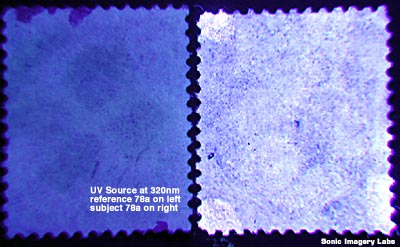The Scott #78 was issued in 1862 with an earliest known cover reported on October 29th 1862. Approximately 9,620,000 are estimated to have been produced. Several varieties exist, most notable being the scratch under the "A" in postage and a printing on both sides. The issue was produced from one plate called "6". The Scott #78 can be found in shades of lilac, dark lilac, gray lilac, gray and blackish violet. It is typically found with black, blue, red, magenta and green colored cancels and many cancellation varieties exist.
New Rev5.1 Design, November 2007
Buy the Sonic Imagery Labs Specialty Perforation & Grill Multi -Gauge
Download Instruction Sheet for the Sonic Imagery Labs Specialty Perforation & Grill Multi -Gauge
Download a MAIL ORDER form for the Sonic Imagery Labs Specialty Perforation & Grill Multi -Gauge
Another Bogus Scott 519 - New November 2002
The Fake Scott 346 Private Perf - New October 2002
The Most Impressive Fake Scott 62B
The Secret Life of an Altered Scott 72
The Secret Life of a Chemically Altered Scott 78
The Secret Life of an Altered RW5 Duck Stamp
A Fake Scott #320 with Schermack Type III Perforations
Fake Scott #743a
Detecting a Flat Plate Press Vertical Coil, Fake Scott 441
Fake Reperfed 514a
Fake Reperfed 508c
Fake Reperfed 546
Fake Scott 143 w / Bogus Grill
Fake Scott 137 w / Same Bogus Grill as Fake 143
Fake Scott 139 w / Same Bogus Grill as Fake 137 and 143
Fake Scott 315 - Revised June 2002
Fake Reperfed Scott 519 - Revised June 2002
A Gallery of Bogus Stuff Part 1
A Gallery of Bogus Stuff Part 2
A Gallery of Bogus Stuff Part 3
A Gallery of Bogus Stuff Part 4
A Gallery of Bogus Stuff Part 5
Credits, Inspiration and Links of Interest
Bibliography of Research Material I Use for this Site
Download the Schermack Type III Go-NoGo Gauge
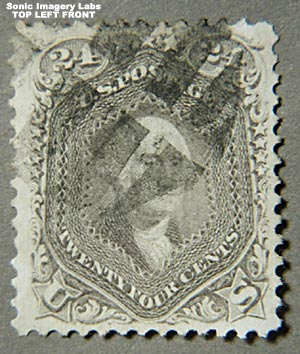
I received our specimen from Dundee Import and Export Services Ltd, incorporating Dundee Advisory Services, T/A "Crocodiles 'R' Us", (DIES&DAS Ltd) Australia on July 22nd 2002. DIES&DAS Ltd. was contacted by a special client, who suspected that several of their philatelic purchases may have been altered in some way.
Sonic Imagery Labs Philatelic Forensic Division, located in California has, for many months, had a special relationship with DIES&DAS Ltd. We have agreed to examine the items that DIES&DAS Ltd sent to us on behalf of their clients.
Provenance Information
At the time of publication of this report the only purchasing information we have is that it was purchased on eBay from seller ID "pcheltenham". eBay item number 1352197744
Upon examination with only the naked eye the subject appears to be very well-centered, with medium margins and a killer cancel in the upper left corner. The cancellation ink spills off into 5 of the perforation holes at the top edge. The cancellation ink also spills off into 5 of the perforation holes at the left edge.
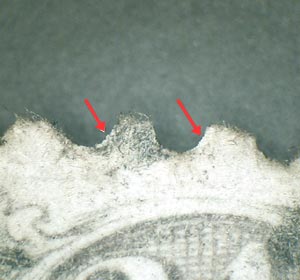
Part I.---- Tidy up and Reperf Job-----
Under magnification and direct lighting, the first signs of alteration start to become clear. The red arrows on the photomicrograph to the left indicate that the perforation hole has been altered or cleaned up. The original ink of the cancellation is missing and clean white paper is exposed.
Most of the perforation tips appear authentic. They show signs of cancellation ink and the paper fibers appear to be pulled away in a genuine manner.
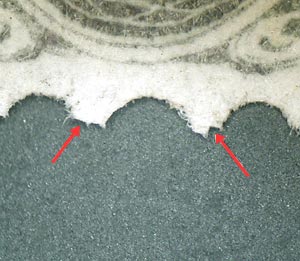
Part I.---- Tidy up and Reperf Job-----
The bottom edge of the subject shows signs of alteration in a different manner. The red arrows on the photomicrograph to the left indicate that the perforation hole has been altered or touched up. The perforation tips show clean white paper at the cuts. This is similar to the double cut and pull method of alteration, except that the cuts are too deep and no material was left to create the tufts of fiber which are characteristic of this method.
Also note that the middle hole is much larger than the holes alongside it. The left edge of the center perf hole's edge is very clean and sharp. This is not indicative of a genuine perf hole.
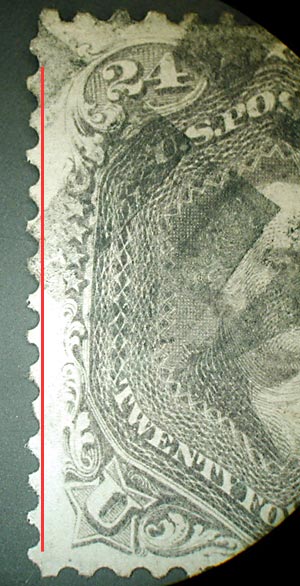
Part I.---- Tidy up and Reperf Job-----
Under medium magnification, the left edge of the subject appears to have been cleaned up. Many of the perforation holes have been cleaned up. What is interesting to note is that the holes that have the cancellation ink soaking into them have not been altered.
The red lines on the photomicrograph to the left help the eye judge the relative straightness of the perforation edge. This technique can be done at home if you have a computer and a scanner. Many image processing programs will allow you to draw perfect boxes or straight lines on scanned images.
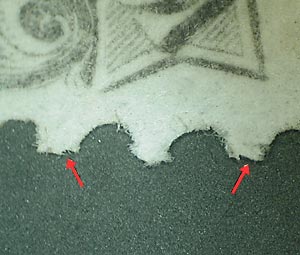
Part I.---- Tidy up and Reperf Job-----
The red arrows in the picture to the left point out the double cut and pull. By making a small cut on each side of the perf tip and then grabbing the tip end with tweezers and pulling, the faker can make the tip produce loose fibers sticking out like a genuine stamp. If the subject had a damaged or straight edge, the faker can help hide evidence of this alteration. Why would the faker want to do this? By reperforating that edge the faker could make the stamp appear more centered. Remember centering is one factor that defines value. (F, F-VF, XF, and Superb)
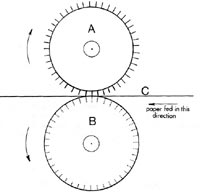 The image of the wheels shown here illustrates how stamps were perforated. The sheet of stamps is shown as the letter "C". The wheel "A" has pins that punch the holes into the sheet of stamps and line up with matching holes in wheel "B".
The image of the wheels shown here illustrates how stamps were perforated. The sheet of stamps is shown as the letter "C". The wheel "A" has pins that punch the holes into the sheet of stamps and line up with matching holes in wheel "B".
Because the contract printers for the post office department used this method, it produces slightly oval holes. Oval shaped holes makes the forger's life very difficult. Conversely it helps us detect when a stamp has been reperforated.
Check out the Fake Scott #519 and Fake Scott #72 article on this website and note the similarities of the perforation alterations. Then check out the RW5 reperf job and note the different reperforation "fingerprint".
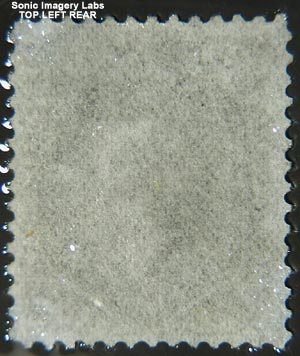
Part 2. -----Look for flaws and repairs-----
Here is our subject floating around in watermark fluid. Watermark fluid is a great indicator of repaired and sealed tears. It will also reveal paper thins as darker areas if the tray or background is black.
Our subject does not appear to have any obvious physical damage.
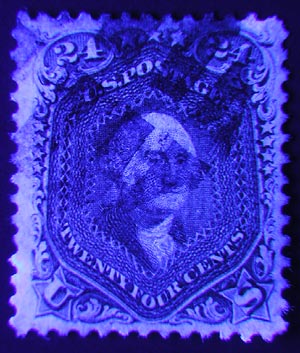
Part 3. -----Chemical Alteration-----
The following images are of our subject exposed to different wavelengths of UV light. Why is this important and why do we care? Because by changing our light source, its discrete wavelength, and its intensity we can cause atoms and molecules of differing materials to fluoresce, glow, absorb, or change color to detect flaws or other hidden defects that our eyes can't normally see. This technique also reveals whether certain modern-day cleaning fluids or acrylic paints or inks have been applied to the stamp to enhance it in some way.
Our subject under very short wave UV. He appears to be violently luminescent. This happens when a stamp is washed in a cleaner or laundry detergent that has a fluorescent chemical brightener added to it. The brightener gets into and coats the paper fibers and is difficult to rinse out.
Stamps of this era are never fluorescent or luminescent.
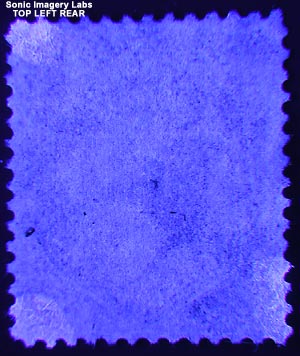
Part 3. -----Chemical Alteration... Help me I'm glowing!-----
Our subject's backside under very short wave UV. There also appears to be some adhesive or chemical at the 3 far corners. It is not uncommon for the use of cyanoacrylates to be used in the repair of stamps. By adding "Superglue Thinner" to a cyanoacrylate adhesive, its viscosity can be lowered so it will easily soak into paper and becomes very useful for sealing tears. In this case there is no evidence of a tear or delaminating of the paper fibers.
At extreme magnifications, the corners of the stamp do appear to have small crystals of an adhesive tangled among the paper fibers. The adhesive crystal formation is smoother and more consistant with a product called "Tak Pak" than a thinned solution of "Super Glue", which produces a granular structure in open air or on flat open surfaces.
A solvent called Methyl Ethyl Ketone (MEK) will turn dryed cyanoacrylate based super glues into a fine white powder which then can be rinsed off in warm water. MEK on "Tak Pak" will turn into a brown fine powder and requires more rinsing and can stain the paper. No attempt was made to do this as the subject did not belong to the lab.
Had the paper been thinned, delaminated, or split internally at the corners, it would of shown at the corners when immersed in watermark fluid as a dark area below the glue. Perhaps, in the subject's past life, the stamp was simply glued to a page in an album.
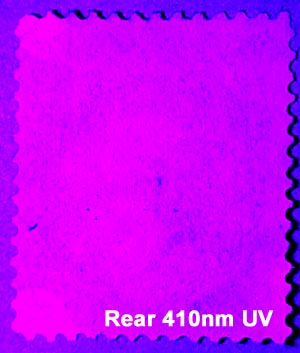
Part 3. -----Chemical Alteration... Help me I'm glowing!-----
Our subject's backside under long wave UV. Note that the corners do not fluoresce at this wavelength. What does stand out at this wavelength is biological material. In this case biological material does not glow but appears very dark.
The dark spots which appear to be paper inclusions are actually crumbs of food particles. At very high magnification, they appear to be crumbs from a coconut / sugar and cinnamon covered mini - doughnut. Several pieces of this material were placed on a calibrated flavor verification device (my tongue). The instrument (my brain) verifies a sugar component.
